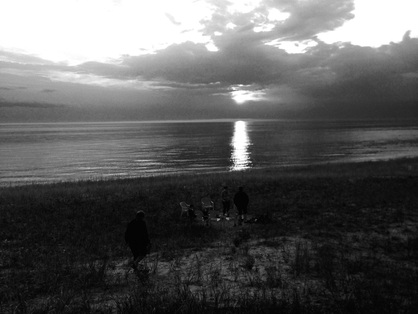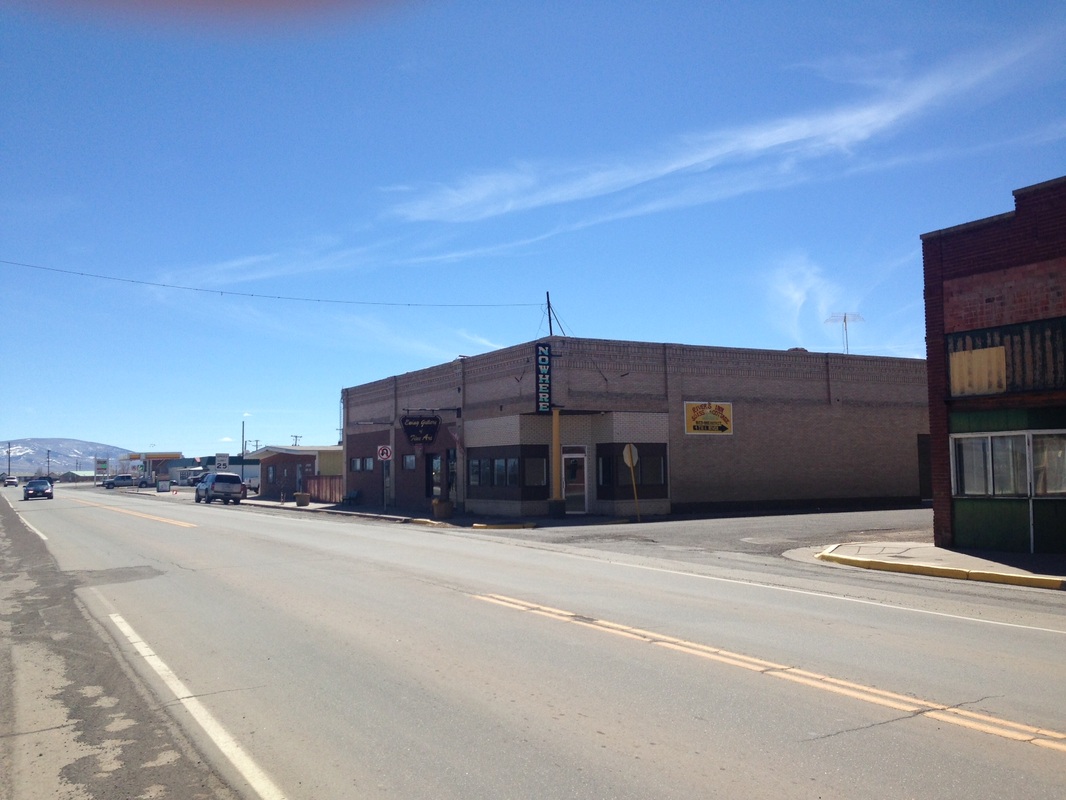|
One • Art that has some dirt on it; recent examples include Sun Kil Moon's Benji and the films of Richard Linklater and Joe Swanberg. The latter shot Happy Christmas on film, spent the film's whole small budget in fact purchasing film. He shot the movie at his own house, with his own two-year-old son playing the role of his character's two-year-old son. I am grateful for imperfection and incompleteness. I am grateful for naturalistic, shaggy, informal, and spontaneous art-making. I am grateful for conversations.
Two • The essays of Gretel Ehrlich, her reflections on Wyoming's culture and geography, and in particular this passage: "Perhaps despair is the only human sin. Who am I to feel disappointed? Is a bird disappointed in the sky?" Three • A website called DuoLingo that offers free, comprehensive language lessons. This is an amazing resource for language learning. It keeps track of your progress, lets you set a daily goal, rewards you with points and levelups and such. I am grateful for languages, for their sonic beauties, their odd back alleys and dead ends. Four • Topography; simply topography. An earth that is not flat, an earth with mountains, canyons, river valleys, arroyos. I am grateful for the Sun Mountain Trail in Santa Fe, New Mexico. From the top you can see four different mountain ranges. I am grateful for each, and for a spot in between them. Five • The United States Postal Service. Sending and receiving mail is the best. I love the feeling of hand-addressing an envelope. I am grateful for ZIP codes in general, because I think they are cool, and for each ZIP code in which I have personally resided, which have begun with the numbers 5, 6, 7, and 8. I'm grateful for this cool map that shows the nationwide breakdown of ZIP distributions. I am grateful for my friend Alex's Zip Code Memoir. (I'm admittedly unconvinced on this whole ZIP+4 situation.) In one episode of The Adventures of Pete and Pete, the titular brothers are excited for the autumn Daylight Savings switch because they believe it gives them the opportunity to travel through time. The only caveat is that they must eat lots of Riboflavin to avoid getting stuck between time zones forever. Isn’t it amazing how the time change manages to bring a shift in light, a different quality to the air? These liminal days at the cusp of seasonal changes do seem to offer a kind of time travel. The past becomes palpable. The smell of wet leaves in the fall, the crispy air after a hard freeze, and the first hot, humid morning in May are pivot points one can use to access seasons of the past. All at once you can remember how they felt. Your past and present are separate planes suddenly and ephemerally tangent to one another.
On each Equinox, theoretically, day and night are of equal duration, and every place on the planet sees the same amount of daylight. In 2008 I wrote a one-act play called Equinox that takes place at a remote oil station in northern Alaska. As the Vernal Equinox approaches, each day is seven minutes longer than the last, and at night, the two men at the station encounter younger versions of themselves. First each man meets the other’s younger incarnation, then the two young apparitions discuss the workings of the universe while watching their older selves asleep. The older men are so shocked by the situation that they never notice their younger selves’ distinct lack of surprise. They say on the Equinox an egg will stand on its end. Eggs as a fertility symbol have long been associated with the Vernal Equinox, but why should the balance of light around the globe for one day have any gravitational effect on an egg, or on anything else? The myth is an enigma. What effect, exactly, do we suppose that a balance of light has on us? The writings of Joseph Campbell have changed my life on two non-consecutive occasions (The Power of Myth, in 2008; The Hero With a Thousand Faces, in 2013). In The Power of Myth, Campbell tells Bill Moyers the following:
“A dream is a personal experience of that deep, dark ground that is the support of our conscious lives, and a myth is the society’s dream. The myth is the public dream and the dream is the private myth. If your private myth, your dream, happens to coincide with that of the society, you are in good accord with your group. If it isn’t, you’ve got an adventure in the dark forest ahead of you.” When I finish a score I write the date and location of composition at the end; when I finished The Accounts, thinking of this passage, I wrote “May 2011 -- the d.f.” According to The Hero with a Thousand Faces, hero’s journeys begin with a call to adventure that is often initially rejected, but around the time the first step is taken, that step into the forest, that step into the unknown and into another world, the hero meets with a mentor. A guide. Generally this figure is a wise old person. (Obi-Wan Kenobi, in Star Wars; Farder Coram, in The Golden Compass; Dumbledore, in the Harry Potter books.) The wisdom says, “leap, and the net will appear.” The hero leaps, and the mentor is there to help guide her. This is early in the journey, so the hero is still suspended in midair, not knowing the profundity of what is to come. The hero does not understand all the things this mentor says to her; but she will. In my life this person might be J.S. Bach. You know, I didn’t care for his music at first. Around the time I got serious about piano in high school, I was most interested in Debussy, in twentieth-century music. Bach and his Baroque era seemed dry by comparison, and were always at the bottom of my list. But the summer before I left for college, my piano teacher said she couldn’t in good conscience send me to a university music program without having played any Bach, so she assigned me a Prelude and Fugue: C# Major, Book One. It knocked me out. Right away I recognized the music’s intense, kinetic logic. You can hear it, and you can feel it in your hands. Bach’s fugue writing has been compared to the playing, and effortless winning, of three or four simultaneous chess matches. I have another favorite game metaphor: playing one of these fugues is like storming through a crossword puzzle. Rather than words, the entries are melodies, and they lock together, one after another, as you hear the piece unfold beneath your fingers, and in the final cadence as the voices converge on that tonic chord, you watch the last few letters fall into place. When I got to college I was assigned to the studio of Larry Campbell, a formidable pianist with a powerful mind and a vibrant musical imagination. On Monday nights at eight o’clock we gathered in his studio for rep classes. The lights were very low, and he would sit by the window, presiding quietly, leaving lots of gaps in the conversation for reflective silence. Each of us would play, and as we finished, the piano’s reverberations would flutter off to the corners of the room, where it was dark enough you could almost see the music hanging in the air. Then Dr. Campbell would ask for comments, and he would wait patiently, never interrupting or clarifying, while each of us stumbled through some sort of response to the playing. He really liked to make us talk. He used to ask questions like “what does Beethoven teach us?” (prompting us each for a one-word response) or “what is the downbeat of this piece, the real structural downbeat?” He would ask me to verbalize my interpretation of a passage in Chopin or Liszt, but in the same breath he would apologize for the question, acknowledging that “music is so much more precise than words.” He also once told me he liked his students always to be working on some Bach and some Debussy, because of the divergent ways those two composers approached keyboard writing. And I’ve never forgotten the evening when, during a studio dinner party at his house, Dr. Campbell said that in J.S. Bach’s music you could find everything sought by any contemporary composer. What did he mean by that? Was it an insult to more recent composers and styles? I don’t think so. Dr. Campbell was not a new music specialist, but he did assign me pieces by Dallapiccola and Webern. The comment was directed rather at Bach, whose music is encyclopedic in its reach. Another teacher called his late Art of the Fugue a compendium—an effort to compile and convey all the techniques of a specific musical style. And that style was narrowly circumscribed in some ways—contrapuntal rules, stylistic norms. People love to talk about how Bach wrote a cantata every week for his church. He is one of the classic paragons of focus and discipline. But the deeper I get into the Well-Tempered Clavier, the more I’m impressed primarily by his endless, depthless invention and creativity within these supposedly restrictive forms. A Prelude and Fugue for each key, and each has its own texture, its own distinct emotional content. Each piece is a self-contained world. They’re like crossword puzzles in that they proceed according to consistent rules, but they all point in different directions, conjure different scenes: day, night, a castle, a forest, a march, a dance, an aria, a recitation. The coincidence of surname between the two scholars here discussed has not escaped me. Dr. Campbell was a guide for me too, a mysterious and contradictory one. I had no idea the magnitude of the journey I was beginning, and he didn’t try to square me for a musical career. Instead he just taught me a lot about music, how to play it and how to try to talk about it. I wish I could play Bach for him again now. He died in July 2011. I stepped into the dark forest around the time I left graduate school in 2009—in fact when Dr. Campbell passed away I was quite literally in the forest, leading a backpacking trip in the Weminuche Wilderness near Durango, Colorado. Every day since I left Austin in 2009, life has proved a wonderful and terrifying adventure. I didn’t know where I was going, as a person or as a musician. I was a bit like Alice chasing the white rabbit. I felt an energy, and I followed it. But as soon as I stepped into the unknown, there was Bach. In 2009 I began to practice the Preludes and Fugues, and today I take the Well-Tempered Clavier with me everywhere. I like to play through at least one piece every day, preferably in the morning, to calibrate my mind and spirit, to get things vibrating on the right frequency. Everyone who writes or composes talks about the terror of the blank page. Leap, and the net will appear. |
A Selection• Gone Walkabout
• Migration • Music as Drama • Crossroads II • 10 Best of 2014 • January: Wyoming and the Open • February: New Mexico and the Holes • Coming Up • Notes on The Accounts • Crossroad Blues • Labyrinths Archives
October 2020
|


 RSS Feed
RSS Feed